Hello and welcome,
I want to begin this week saying how saddened we are by the sudden loss of Justice Antonin Scalia, who was a brilliant jurist and a man who lived his faith very seriously. We join with Americans everywhere in tendering our condolences to his wife and nine children. A few years ago, he graciously accepted my invitation to come to Boston and address our Boston Catholic Lawyers Guild at the annual Red Mass celebration.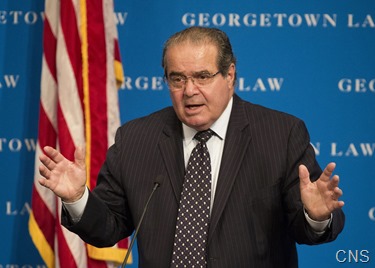
His son is a priest of the Diocese of Arlington, Virginia and I understand that his funeral will be at the National Shrine of the Immaculate Conception.
He will be sorely missed and we pledge our prayers for his family and loved ones.
– – –
I also want to note the passing of Sheila Feitelberg, whose wake I attended on Friday afternoon. 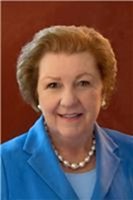
She had been living in Boston but was originally from Fall River. In fact, the Feitelbergs were my neighbors in Fall River. Sheila, and her husband Joe, were very involved in the works of mercy of the Order of Malta.
– – –
Of course, this week the Holy Father made his pastoral visit to Mexico. However, before that, he made a stop in Havana to meet with Russian Orthodox Patriarch Kirill.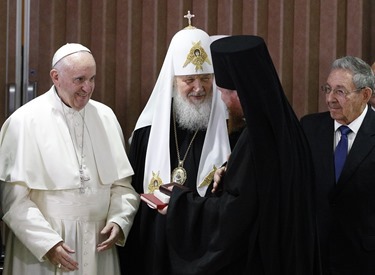
This was it an extraordinary event in the life of the Church. For the first time in 1,000 years, the Pope of Rome and the Patriarch of the “Third Rome,” Moscow, were brought together in an ecumenical meeting. The patriarch is the man who is responsible for the largest population of Orthodox Christians in the world. The fact that it was held in Cuba added to the extraordinary nature of the meeting.
So many of the themes that were discussed – the plight of refugees, Christian unity, the environment – are of universal concern. It has come to a point, I believe, that Orthodox Christians are beginning to realize that in today’s world it is important to support other believers and Christians who share similar values with them. Hopefully, this meeting will be a very important step, in the same way that the meeting in the Holy Land of Pope Paul VI and Patriarch Athenagoras was 50 years ago. Ever since then there have been warm relations between our two Churches, as is evidenced in the many meetings between the Patriarch Bartholomew and the Holy Father.
– – –
On Friday, I paid a visit to the newly refurbished Lower Mills Campus of St. John Paul II Catholic Academy in Dorchester.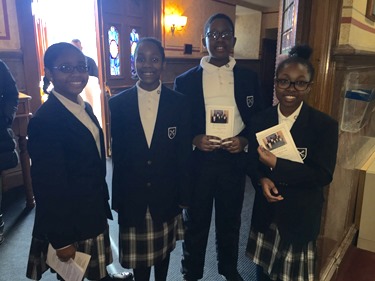
I celebrated a Mass for them at St. Gregory’s Church. Jerry and Maureen Sheehan were present with us, as well as some of the other principal benefactors of the school. At the Mass, I was able to thank the Sheehan family for their support of Catholic education.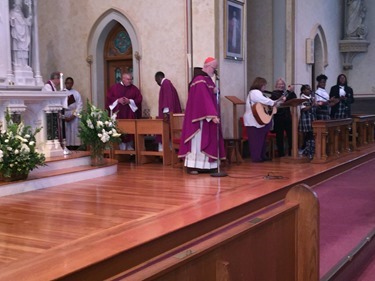
The celebration of the Mass and singing of the children was very uplifting.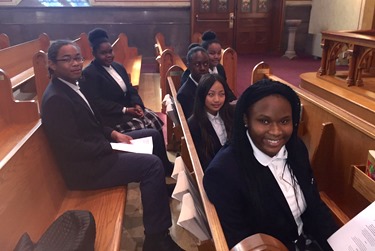
One of the children addressed us at a breakfast. She gave a touching and faith-filled testimony of her own personal life of discipleship and the benefits that Catholic education has brought to her life. Sister Ellen Powers also gave a wonderful address on Catholic education.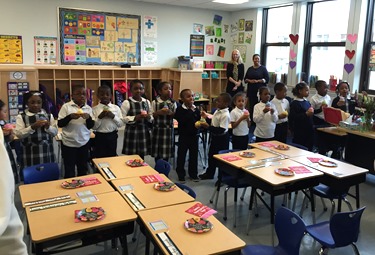
During my visit, I had a chance to stop by some of the classrooms. I was very amazed and delighted to see that there are a large number of Haitian children among the student body there.
– – –
Saturday, I delivered a talk at the St. John’s Seminary faculty retreat, which was held at the Cathedral.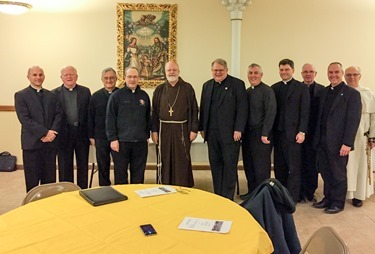
It was very good to be able to be together with them.
– – –
Sunday, I had the joy of celebrating two ceremonies of the Rite of the Election at the Cathedral. 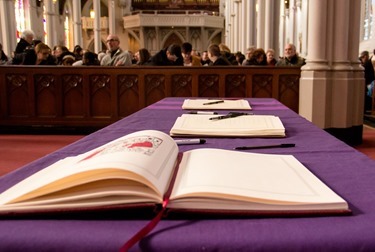
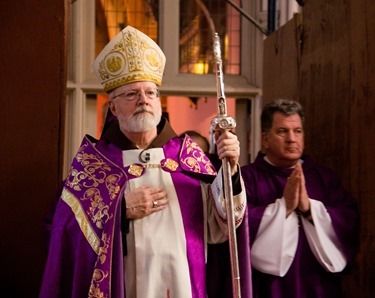
The First Sunday of Lent is always a very special moment in the life of the Church because, in all the cathedrals in the world, bishops receive the catechumens and the candidates who will be baptized and received into full communion with the Church at Easter.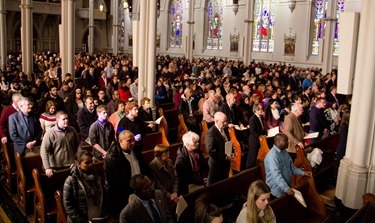
As I told the people, the beautiful subzero weather was the result of the intercession of St. Valentine because last year we couldn’t hold the Rite of Election at the cathedral because we were all buried under feet of snow!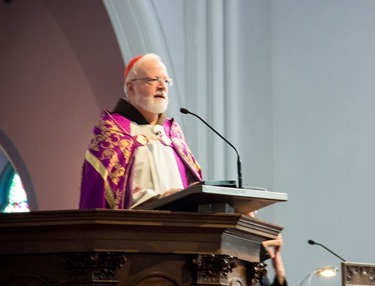
In my remarks, I mentioned that for a long period in the history of the Church the bishops performed all the baptisms, but in modern times the bishops perform Confirmations and preside over the Rite of the Election as a symbol of the unity of the Church. Bringing them together at the Cathedral is an opportunity for them to experience their membership in a community that is not just a local parish, but also the diocesan and universal family that is the Catholic Church.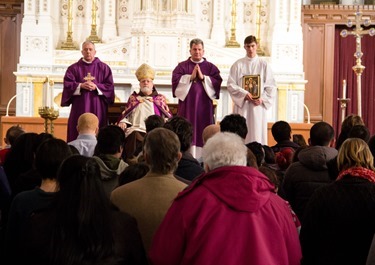
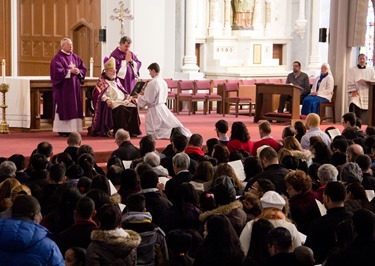
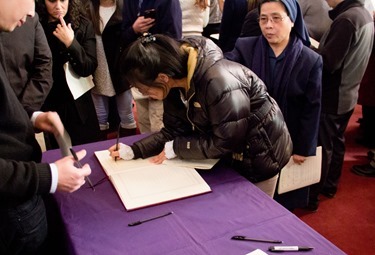
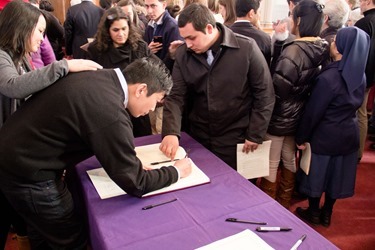
We are very grateful to all the parishes that run the RCIA programs, which are such an important means of evangelization and also a way of raising consciousness in the parishes of our mission to be a welcoming and evangelizing community.
– – –
On Monday, I departed for El Paso to be present for the Holy Father’s visit to the U.S.-Mexico border.
While in El Paso I was invited to celebrate Mass with the bishops and many of the leaders of the Diocese of El Paso. It was held at a very beautiful church, St. Pius X.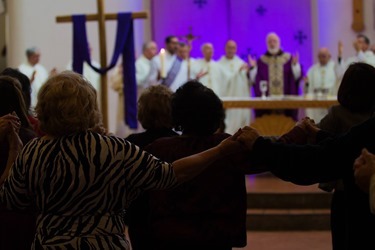
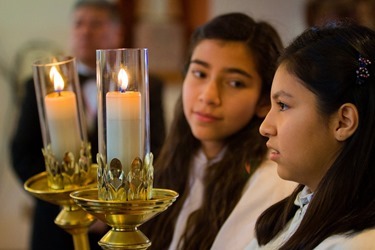
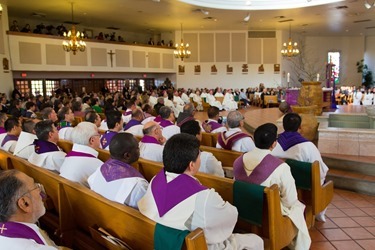
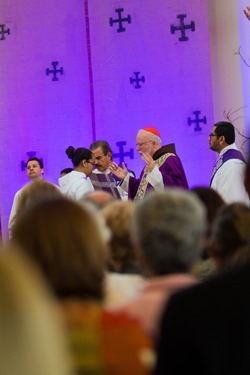
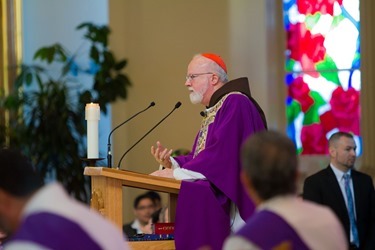
Bishop Mark Seitz and the whole diocese worked very hard to prepare a celebration in El Paso as the Holy Father was celebrating just over the border. (El Paso is a Twin City with Ciudad Juárez – in fact they are almost the same city, just divided at the border.)
After the Mass at St. Pius X, we went over to Ciudad Juárez where we stayed until the Mass with the Holy Father.
The Bishop of Juárez, Bishop José Torres, was very gracious to us and his Vicar General, Msgr. Blanco, was the one who shepherded the whole American group around.
The owners of the Quality Inn provided complimentary lodging for all the bishops and the other Church officials who came for the Papal Mass. As I told the owner of the hotel, in the States when there is a papal visit they usually increase the rates, but here they were giving us the rooms for free! I thanked him for this very generous gesture.
I was very happy to see that the situation in Juárez seems to have improved. At one point, Juárez was the murder capital of the world. In fact, when I was a priest, one of our parishioners was murdered there, and I went to bury him in the desert with his family. So, as you can imagine, I had a very sad association with Juárez. But, going back and seeing that the city has become safe once again, seeing throngs of people in the center of the city and the churches filled, was quite a joy.
During our time in Juárez, we visited the original mission that was the foundation of the city. Ciudad Juárez and El Paso were founded by Fray García de San Francisco in the 1650s; he named it Mission Nuestra Señora de Guadalupe. 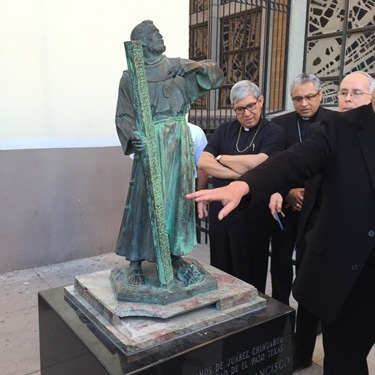
The original mission church is still there and is beautiful, with a stunning ceiling with carved wooden beams.
The centerpiece of the church is an ancient image of Our Lady of Guadalupe.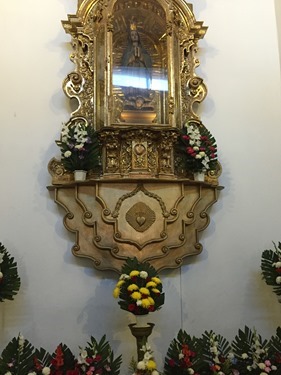
When we got to the church, it was filled with people waiting to go to confession. So, Msgr. Blanco, who was guiding the tour, asked the bishops if they would be willing to hear confessions. We all sat down to begin hearing confessions and finished off the crowd in half an hour!
– – –
Wednesday, of course, was the Mass with the Holy Father. He visited a local prison earlier in the day where he gave a magnificent address to the inmates, and then in the afternoon was the Mass at the border.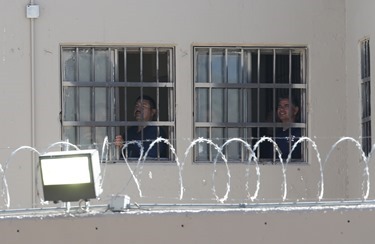
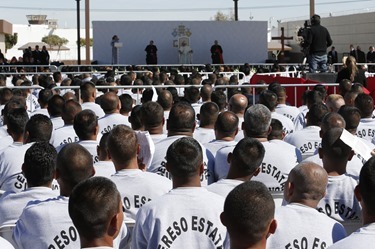
Before celebrating the Mass, the Holy Father went to a point very near the border looking out over El Paso. 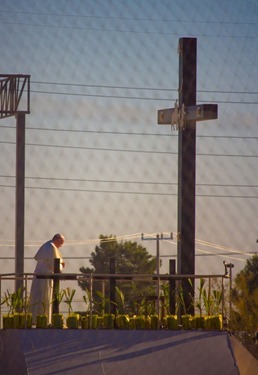
After praying at the large cross there and blessing the people in El Paso, he proceeded to celebrate the Eucharist at which he gave a beautiful homily addressing the challenges of forced immigration.


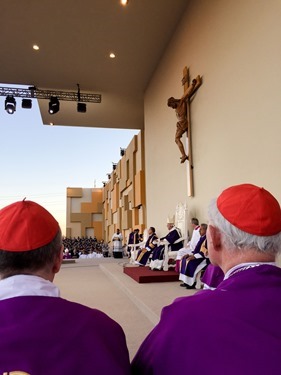

The reason I went to Juárez is that the Holy Father’s presence there is of such crucial significance to us as a Catholic community. In the world today we have a crisis of refugees and immigrants. There are millions of refugees in the world and, in our own hemisphere, the suffering of so many immigrants is something that needs to be addressed by careful and thoughtful legislation. It is not a political problem, not a problem of statistics or programs, but is a human problem. The Holy Father’s coming to the border was to emphasize the humanity of the immigrants and, in a very dramatic way, to appeal to people of goodwill to seek paths that will bring about greater justice for so many suffering people and help families that are divided to be reunited.
Reflecting on these themes, I wrote this reflection, which I would like to share with you here:
The pastoral visit of Pope Francis to the city of Juarez on the U.S.-Mexican border came at a providential time. The fact of an historic moment in global immigration, affecting Africa, the Middle East, Europe, Central America and the United States simultaneously, means that the Holy Father’s words and deeds at the border will draw attention throughout the world. What he said and did will be seen and understood in a broader perspective than the United States and Mexico alone.
The visit was providential because, faced with a global crisis, democracies of East and West are having enormous difficulty thinking about, speaking about and acting upon the crisis in a productive way. In the United States the question of immigration policy, affecting millions within our country and thousands on our borders, has produced both powerfully held convictions and deep divisions. These in turn have made a rational response to the crisis virtually impossible to achieve. Politically and legally we are in gridlock, a condition which democracies often face, but which on this question seems to be a permanent condition.
In the midst of this division, in the face of debates which often lack civility, much less compassion, Pope Francis focuses on the human dimension of the immigration crisis. The human dimension involves two profound truths: the dignity of every human person and the common humanity we share as persons. These two truths, repeatedly stressed in the Holy Father’s ministry and teaching, are the heart of the human crisis of migration and immigration. But these truths, deeply human, moral and religious in their content, exist in a world of great conflict and complexity. The immigration crisis cuts through the basic levels of our existence as a human community, the crisis is simultaneously global, national and local.
It is a global problem because in a globalized world, market and economy, migration will happen. In a world where ideas, resources and interests cut across national borders each hour of every day, people also will move, either by desire and choice or from coercion and chaos. Migrations have marked human history for millennia; today they have reached historic proportions. It is a fact of life.
Immigration then becomes a national question as states must shape national policies in a globalized world. Because human lives and human dignity are at stake, it is reasonable to expect that national policies will combine secure standards of safety for states, compassion toward those often in life threatening situations, and recognition that policies of nations like the United States will establish precedents, good or bad, for others.
National policies will become local questions because migrants and refugees will need welcome, support and understanding at the local level. Unlike other global problems like arms control or complex financial relationships, immigration is one of those problems which engage people at the most local level of existence.
How then should this global, national and local challenge be addressed? The Holy Father always begins with the person, with his or her dignity, with their humanity, with their needs and the dangers they face each day. His ministry has consistently been about reaching across boundaries and frontiers which seem impregnable, but in fact are open to human initiatives and humane policies. His pastoral visits and his constant teaching are about crossing lines. He did this with powerful consequences in his visit to the United States. So, to learn from him means that the first question of immigration policy should be the identity of migrants and refugees within our country and at our borders.
How we think about them, how we speak about them, how we decide policy will all be powerfully influenced by how we see them. They can be called migrants or refugees, they can be described as Syrians or Salvadorans, they can be known as Muslims or Christians. But it is a mistake to begin in this way, and a failure of moral imagination to end this way. None of these titles, while important eventually, touch the deepest meaning of the immigration crisis. Before all else in every migrant, refugee or family escaping danger and destitution we meet the human person, sharing our humanity, sharing our vulnerability to conditions of war, conflict, poverty and discrimination.
Too often our public debates about immigration focus on secondary characteristics of human identity. Religion, race, ethnicity and nationality are important, but they are secondary to human dignity and human uniqueness. The ancient religious belief that each of us is a unique creation of God has in our time been reinforced by the scientific knowledge of the unique character of our DNA. We cannot ignore this truth if we are to respond from our humanity to others in danger and in need.
My hope and prayer is that Pope Francis’ visit to the U.S.-Mexican border will help us all — of many faiths and of none — focus on dignity and humanity. We are invited, I believe, to think again deeply about our world, our country and our convictions. Our world produces, through choice or coercion, the fact of migration. Our country must produce a policy which combines compassion and safety. Our convictions, religious and rational, are challenged and invited to use the necessary standards of compassion and effectiveness to meet this crisis of our time.
Until next week,
Cardinal Seán
